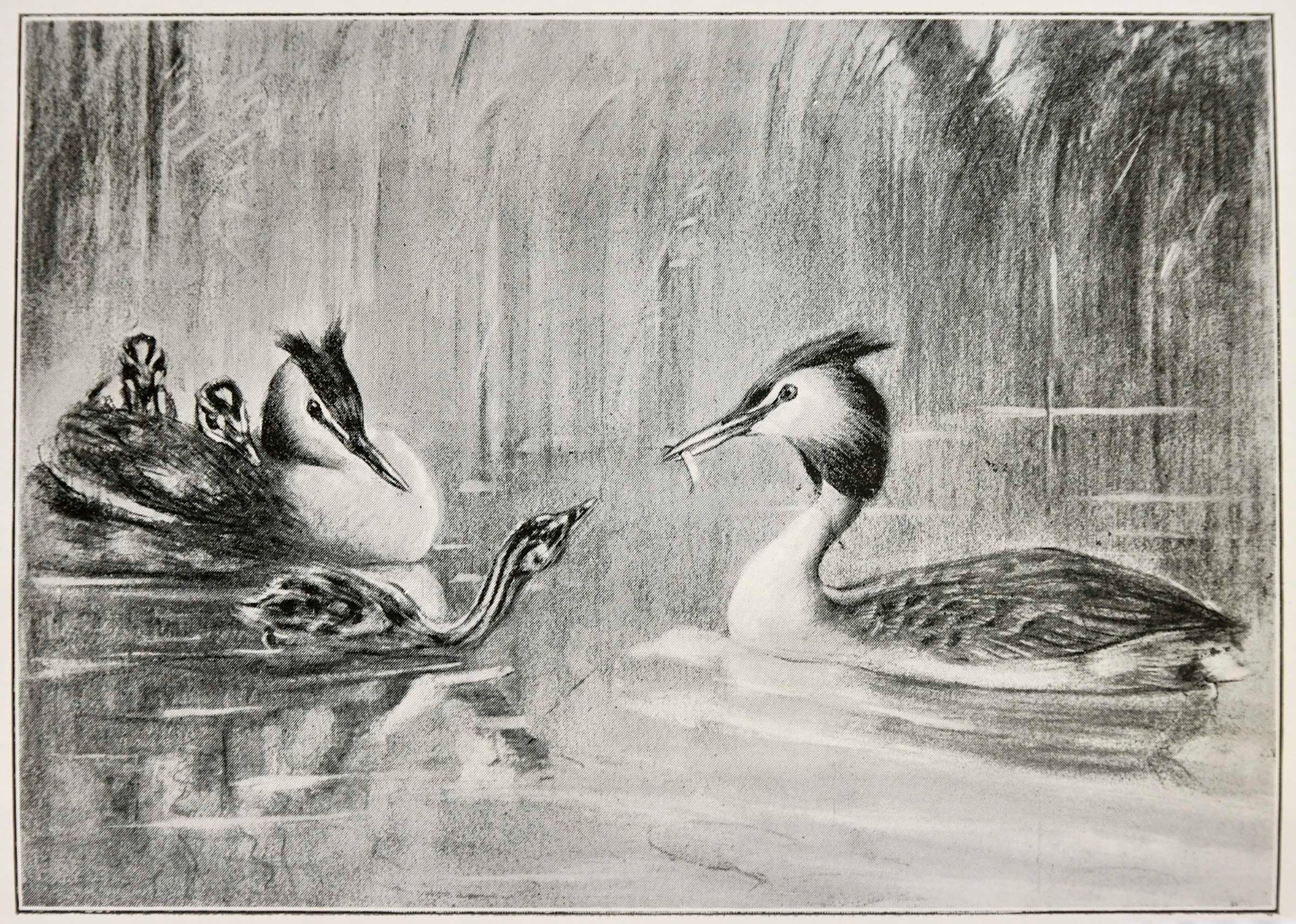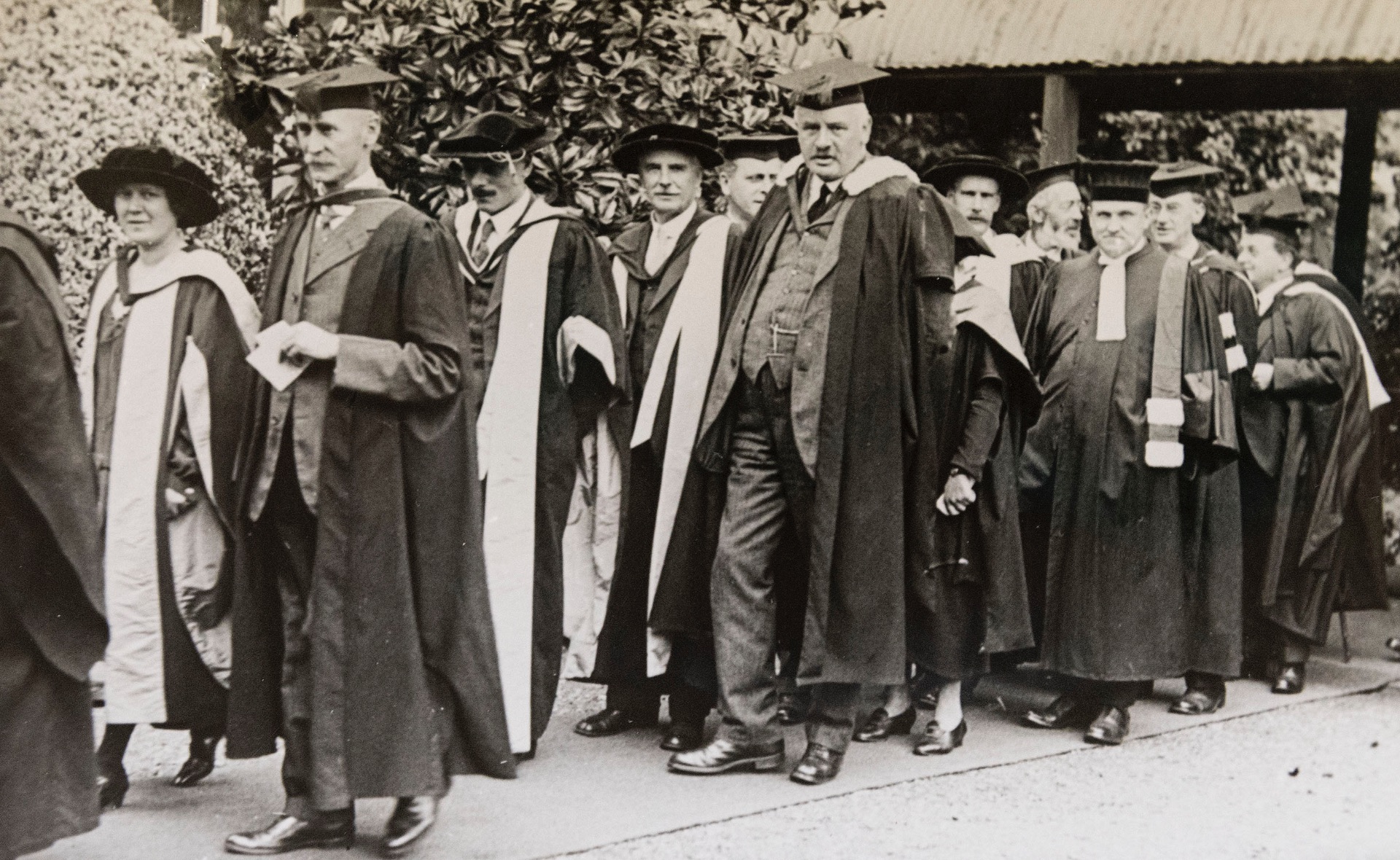In a previous post about the Great Hall, I included Allen Seaby’s illustration of ‘The Hall by Moonlight’, published in Tamesis in 1910. His sketch of great crested grebes at Whiteknights appeared in the College Review in the same year.

It has been estimated that the lake was first colonised by the grebes in about 1885 and a pair was recorded by the eminent ornithologists T. Harrisson and P. Hollom in their national survey, ‘The Great Crested Grebe Enquiry‘, conducted in 1931. Other sightings in the Reading area included Maiden Erleigh Lake and Bulmershe.
Purely by chance I came across Seaby’s sketch just as the grebes’ descendants were hatching their eggs on today’s lake.

Allen Seaby had a lot more to say about the Whiteknights grebes in his book ‘The Birds of the Air’, first published in 1931. This volume gives a comprehensive account of bird life of all types in Britain but also includes chapters on exotic birds in zoos and abroad. His field excursions took him from the Shetlands in the north to the Scillies in the south. His chapter on ‘River and Lake‘, however, focuses on the Reading area, the rivers in question being the Thames, the Kennet and the Loddon, and the lake being the one in Whiteknights Park. This was just over 15 years before its purchase by the University of Reading.
‘The lake I know best is Whiteknights Lake, at Reading. It is an artificial one, but the trees growing on its banks have relieved it of any formality. Under the road [Whiteknights Rd] which forms the dam the surplus water flows, to fall in a cascade on the other side.‘ (p. 35)
He mentions moorhens, coots and the pied wagtail (a ‘dishwasher’), tufted duck, pochard and mallard. But he devotes over six pages, including four illustrations, to a detailed description of the grebes, the behaviour and appearance of the male and female, their courtship and nest building:
‘Of all the lake birds, the most interesting is the great crested grebe, which may be watched here during the greater part of the year. Elsewhere, especially on the Broads, it is exceedingly shy and difficult to watch, skulking behind tall rushes; but on this lake, as if knowing that it is in no danger, it lives out in the open. One season it nested so close to the road that I have had to threaten an urchin who was throwing stones at the sitting bird. I remember, though, that it hatched out its eggs and brought off its young safely.‘ (p. 37)
Allen Seaby became Professor of Fine Arts in 1920, having already been Departmental Director since 1911.

There is a glimpse of Seaby (bearded) in this photograph of the degree procession in October 1928. He can be spotted between H. L. Hawkins (Geology) and Prof Desseignet (French), and appears to be talking to Prof Neville (Dean of Agriculture and Horticulture).


An account of his life and work can be found in ‘A. W. Seaby: Art and Nature’ by Martin Andrews and Robert Gillmor, and published by Two Rivers Press. Robert Gillmor was Seaby’s grandson and also an internationally renowned artist and ornithologist.
Post Script
In May 2022 the grebes of today hatched their young, thus repeating the cycle described by Allen Seaby:
‘After a few days the nest is abandoned, the mother’s back becoming the chicks’ home, although they constantly take to the water.‘ (pp. 40-41)
In the image below it is just possible to make out two striped chicks sitting on the back of the female – as in Seaby’s original sketch.

Thanks
Thanks once again to Emily Gillmor for permission to use her great grandfather’s sketch. I was very sorry to hear of the recent death of her father, Robert Gillmor.
Thanks also to Andrew Male for an ornithological tour of the Whiteknights Campus in April 2022, and for identifying the grebes’ nest and tracking down the report on the ‘Great Crested Grebe Enquiry‘.
Sources
Harrisson, T. H. & Hollom, P. A. D. (1932). The great crested grebe enquiry 1931 – Part 1. British Birds, 26, 62-92.
Seaby, A. W. (1910). The grebes of Whiteknights Lake [Sketch]. The Reading University College Review, Vol. II, No. 6, July 1910, between pages 200 & 201.
Seaby, A. W. (1932). The birds of the air or British birds and their haunts (2nd ed.). London: A. & C. Black.
University College Reading. Calendar, 1922-3.
University of Reading, Special Collections. Box of photographs: Processions MS5305.
